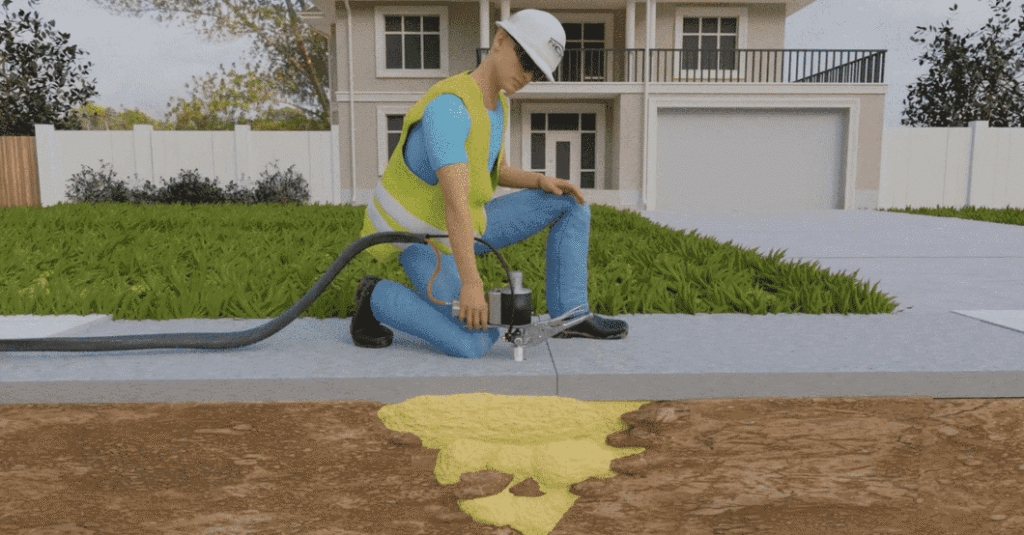Your sidewalks are more than just pathways; they are the veins of your community, connecting neighbors, facilitating strolls, and contributing to the overall aesthetic and safety of your neighborhood. However, time, weather, and unforeseen circumstances can take their toll, leading to cracks, uneven surfaces, and potential hazards. Understanding the concrete sidewalk cost associated with concrete sidewalk repair and knowing when it’s time to take action is crucial for every homeowner and community member. This comprehensive guide will walk you through the factors influencing concrete sidewalk cost and provide insights into effective repair strategies, ensuring safe and appealing walkways for all.
The Importance of Well-Maintained Sidewalks
Before delving into the specifics of cost and repair sidewalk, it’s essential to appreciate the significance of maintaining your concrete sidewalks. Well-maintained sidewalks offer a multitude of benefits:
- Enhanced Safety: Smooth, even surfaces prevent trips, falls, and injuries, protecting pedestrians of all ages and abilities. This is particularly important for children, the elderly, and individuals with mobility challenges.
- Increased Property Value: A well-kept property, including its sidewalks, contributes to a positive curb appeal. Neglected sidewalks can detract from the overall appearance and potentially lower property values.
- Community Aesthetics: Uniform and well-maintained sidewalks enhance the visual appeal of your neighborhood, creating a sense of pride and care.
- Preventing Further Damage: Addressing minor cracks and issues early on can prevent them from escalating into more significant and costly problems down the line. Ignoring small repairs can lead to extensive damage requiring complete replacement.
- Liability Reduction: Homeowners are often responsible for maintaining the sidewalks adjacent to their property. Neglecting repairs can lead to liability issues if someone is injured due to a damaged sidewalk.
Understanding Concrete Sidewalk Cost Factors
The cost of concrete sidewalk repair or replacement can vary significantly based on several key factors. Understanding these elements will help you get a more accurate estimate and make informed decisions.
Scope of the Damage
The extent and nature of the damage are primary determinants of cost. Minor cracks can often be repaired relatively inexpensively, while large, uneven sections or significant structural damage will necessitate more extensive and costly solutions.
- Minor Cracks: Small surface cracks, typically less than a quarter of an inch wide, can often be filled with concrete crack filler or sealant. This is a cost-effective solution for preventing water infiltration and further deterioration.
- Uneven Surfaces (Trip Hazards): Sections of the sidewalk that have lifted or sunk, creating tripping hazards, may require more involved repairs like grinding, patching, or mudjacking.
- Large Cracks and Spalling: Significant cracks, especially those accompanied by spalling (surface flaking or crumbling), indicate more severe damage and may require patching or even section replacement.
- Extensive Damage or Root Intrusion: In cases of widespread damage, significant root intrusion from nearby trees, or severely deteriorated concrete, complete sidewalk replacement might be the most viable and long-term solution.
Repair Method Chosen
The chosen repair method will directly impact the cost. Different techniques have varying labor and material requirements.
- Crack Filling/Sealing: This is generally the least expensive option, involving cleaning the crack and applying a suitable filler or sealant.
- Patching: Repairing localized damage by removing the damaged concrete and pouring a new section. The cost will depend on the size and depth of the patch.
- Grinding: For minor unevenness, grinding down the raised section can be a cost-effective solution. Specialized equipment is required for this process.
- Mudjacking (Slab Jacking): This involves injecting a grout mixture under the sunken concrete slab to lift it back to its original level. It’s a less invasive and often more affordable alternative to complete replacement for sunken sections.
- Slab Replacement: Removing and replacing a damaged section of the sidewalk with new concrete. The cost will depend on the size and thickness of the replacement.
- Complete Replacement: Removing and replacing the entire sidewalk section. This is the most expensive option but may be necessary for severely damaged or deteriorated sidewalks.
Size and Accessibility of the Work Area
The size of the area needing repair or replacement directly influences the material and labor costs. Larger projects will naturally require more concrete and more time for the crew to complete. Accessibility also plays a role. If the sidewalk is difficult to access with equipment or if there are obstacles like landscaping that need to be worked around, it can increase the labor costs.
Labor Costs
Labor costs are a significant component of any concrete work. These costs can vary based on:
- Contractor Experience and Reputation: More experienced and reputable contractors may charge higher rates but often provide higher quality work and greater reliability.
- Location: Labor costs can vary geographically depending on the local market rates and cost of living.
- Complexity of the Job: More complex repairs or replacements requiring specialized skills or equipment will likely have higher labor costs.
Materials Used
The cost of concrete itself can fluctuate. Additionally, other materials such as reinforcing steel (rebar or wire mesh), forms, and finishing products will contribute to the overall cost. Decorative concrete options, such as colored concrete or stamped patterns, will also increase material costs.
Permits and Inspections
Depending on your local regulations, you may need to obtain permits before undertaking sidewalk repair or replacement work. There may also be inspection fees associated with ensuring the work meets local codes and standards. These costs should be factored into your budget.
Estimating Concrete Sidewalk Repair Costs: A General Range
It’s challenging to provide a precise cost without a specific assessment of the damage. However, here’s a general overview of potential cost ranges for common concrete sidewalk repairs in the USA:
- Minor Crack Filling: $50 – $200 per crack (depending on length and complexity).
- Patching (Small Area): $100 – $500 per patch (depending on size and depth).
- Grinding (Minor Unevenness): $150 – $400 per affected area.
- Mudjacking (Slab Lifting): $300 – $800 per slab (can vary based on the number of injection points and the extent of the lift).
- Slab Replacement (Small Section): $500 – $1,500 per section (typically a few feet square).
- Complete Sidewalk Replacement: $8 – $18 per square foot (this can vary significantly based on the factors mentioned above).
Please note: These are rough estimates and actual costs can vary. It’s always recommended to get multiple quotes from reputable local concrete contractors for an accurate assessment of your specific needs.
When is it Time to Repair Your Sidewalk?
Recognizing the signs of sidewalk damage early can save you time, money, and potential liability. Here are some key indicators that your concrete sidewalk may need repair:
- Visible Cracks: Any cracks wider than a quarter of an inch or those that are growing should be addressed.
- Uneven Surfaces: Sections that are raised or sunken by more than half an inch can create significant tripping hazards.
- Spalling and Crumbling: Surface flaking or crumbling indicates that the concrete is deteriorating and needs attention.
- Potholes or Depressions: These can collect water and worsen over time, posing a safety risk.
- Root Intrusion: Tree roots growing underneath the sidewalk can cause lifting, cracking, and unevenness.
- Water Pooling: Areas where water consistently pools can indicate drainage issues and potential for further damage.
Choosing the Right Contractor for Sidewalk Repair
Selecting a qualified and reputable concrete contractor is crucial for ensuring a successful and long-lasting repair. Here are some tips for choosing the right professional:
- Get Multiple Quotes: Contact at least three different contractors to get detailed estimates for the work.
- Check Their Credentials: Ensure the contractor is licensed and insured in your state and local area.
- Review Their Portfolio and References: Ask to see examples of their previous work and contact references to inquire about their experience with the contractor.
- Read Online Reviews: Check online review platforms to see what other customers have to say about their services.
- Get a Written Contract: A detailed contract should outline the scope of work, materials to be used, timeline, payment schedule, and warranty information.
- Ask About Their Experience with Similar Repairs: Choose a contractor who has experience with the specific type of repair your sidewalk requires.
- Inquire About Their Process and Materials: Understand the methods and materials they will use and ensure they are of good quality.
DIY vs. Professional Repair
While some minor sidewalk repairs, such as filling small cracks, can be a DIY project, more significant damage is best left to experienced professionals. Attempting complex repairs without the necessary knowledge, tools, and experience can lead to further damage, safety hazards, and ultimately higher costs in the long run.
DIY might be suitable for:
- Filling narrow surface cracks with concrete crack filler.
- Applying sealant to protect against water intrusion.
Professional help is recommended for:
- Uneven surfaces requiring grinding or mudjacking.
- Large cracks and spalling.
- Slab replacement.
- Complete sidewalk replacement.
- Repairs involving significant structural damage or root intrusion.
Maintaining Your Concrete Sidewalks for Longevity
Once your sidewalk is repaired or newly installed, proper maintenance is key to extending its lifespan and preventing future issues. Here are some essential maintenance tips:
- Regular Cleaning: Sweep away debris, leaves, and dirt regularly to prevent staining and the buildup of moisture.
- Prompt Crack Sealing: Address small cracks as soon as they appear to prevent water from seeping in and causing further damage during freeze-thaw cycles.
- Control Plant Growth: Trim back any vegetation that is growing too close to the sidewalk to prevent root intrusion.
- Avoid De-icing Salts: If possible, avoid using harsh de-icing salts, as they can damage concrete over time. Opt for sand or safer alternatives.
- Ensure Proper Drainage: Make sure water drains away from the sidewalk effectively to prevent pooling and potential damage.
Investing in Safe and Accessible Walkways
Maintaining your concrete sidewalks is an investment in the safety, aesthetics, and value of your property and your community. By understanding the factors that influence concrete sidewalk cost and knowing when to seek professional repair, you can ensure that these vital pathways remain safe and accessible for everyone. Don’t wait for minor issues to become major problems – proactive maintenance and timely repairs are the keys to long-lasting and reliable concrete sidewalks.



